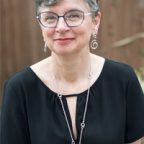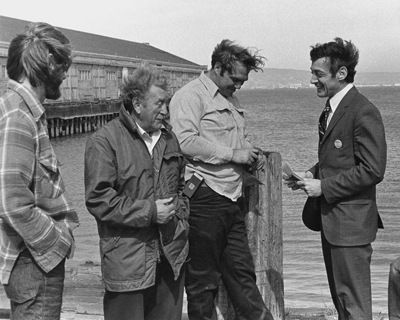On November 27, 1978, Harvey Milk and George Moscone were murdered in San Francisco’s City Hall. Milk was one of the first openly gay politicians in California, and his short political career was not only emblematic of the wider gay liberation movement at the time, but his death and legacy inspired a new generation of activism which was seen not only during the 1980s AIDS crisis, but has lingering impacts four decades later.
In this episode, we are joined by Lisa L. Moore from the University of Texas’s English Department and incoming chair of the new LGBTQ Studies portfolio program, to discuss the legacy of Harvey Milk on the 40th anniversary of his assassination.
Guests
 Lisa L. MooreArchibald A. Hill Regents Professor in American and English Literature at the University of Texas at Austin
Lisa L. MooreArchibald A. Hill Regents Professor in American and English Literature at the University of Texas at Austin
Hosts
 Christopher RosePostdoctoral Fellow, Institute for Historical Studies, The University of Texas at Austin
Christopher RosePostdoctoral Fellow, Institute for Historical Studies, The University of Texas at Austin
Why don’t we start off by talking about who Harvey Milk was and where he came from, and who he was in the historical moment.
Well, Harvey Milk himself likes to refer to himself as a nice Jewish boy from a middle class background that had a good job and insurance and then moved to New York and discovered a whole new life for himself. So he was from a suburb of New York City. He was a well educated person who served in the Navy and worked in finance and insurance. But he was someone who from a teenager also knew that he was gay. And for many years, as many people did in the late 40s and in the 50s, he pursued homosexual relationships mainly in secret. But the 60s kind of caught up with Harvey Milk and changed his view of who he was and what he was doing in a way that he uniquely was able to share with other people in a way that had a big impact.
So, one detail that I love about his biography is that it was actually a boyfriend who was in the cast of Hair–the musical Hair, the big free love musical–that first took Harvey Milk to San Francisco when the show went there. So that was in the late 60s and early 70s, both Harvey and his partner decided to stay there for a few years. And it was in the Castro neighborhood, where there had been a tradition since the end of World War II of settlement by demobilized military officers who didn’t want to go back to their small towns and go back into their closeted lives; it was there in the Castro that you really had one of the first gay neighborhoods in the United States. Other port cities saw similar explosions of gay camaraderie, queer camaraderie in in those years. Harvey Milk was somebody who kind of became an aging hippie because he was not 22 when that happened. And really changed his view about the status of his sexual practice in a sexual preference in relation to his life in the wider culture. And he came to understand that it had value.

San Francisco was one of the places where some of the post World War II and 1950s era homophile associations, as they were known, got started. So the Daughters of Bilitis for lesbians and the Mattachine Society for gay men began to create publications and, and invite experts to give talks to try to explore the idea–which at the time was very heretical, that maybe there was an nothing wrong with being homosexual.
You know, this was at a time when it was certainly it was considered not only a mental illness, but also it was defined as a crime in every state, and federally. It also was condemned by almost every major religion. So this took a lot of creativity, to create some kind of space for push back against that consensus about the evils of homosexuality. And that was something that I think in some ways, because Harvey Milk did have a background of a certain amount of privilege, he was relatively willing to believe that his life had value and that his preferences did not necessarily condemn him to worthlessness and sin. And also because he’d love to refer to himself as the “top queen in any room” that he went into; he was very flamboyant, very funny, very quick witted, loved attention. So he was really able to start conversations that were coming at a slightly later stage than the quiet steady work of the people who’ve been involved in the homophile movement.
So one thing that was interesting is when he decided to run for city City Council, or the Board of Supervisors, as they call it, in San Francisco, he was actually running against a candidate, another gay candidate who was more affiliated with the slightly older generation, the Mattachine Society and so on, who were Harvey Milk’s age. But Harvey Milk was coming in with the the flower child generation and was, you know, sort of more representing this new way of thinking about homosexuality. And that caused a some infighting and some splits in the gay community, because there were certainly were people who felt like other people had really been paving the way for a long time, and had worked their way into the position of being leaders speaking for gay and lesbian people and other queer people in San Francisco. And Harvey Milk was kind of swanning in at the last minute and making a big splash.
So actually, one detail that I find interesting is that Harvey Milk did not initially get the endorsement of the Gay Business Association in San Francisco. It went to this other candidate who had worked with those businesses for a long time, and really had earned their trust. But eventually, Harvey Milk was successful in getting elected to the Board of Supervisors. But the first time he was elected, he actually quit after just a few weeks, because he wanted to run for state Assemblyman. He lost that race. Then he went back to the Board of Supervisors. And it was during that second term, the tragic events that you refer to in your opening started to happen. So it’s interesting.
I mean, San Francisco–the Castro district was at that turning point that we’re familiar with now. We call it gentrification, where an working class community that had been there for a long time was starting to be displaced by, in this case, gay people, but other people from other parts of the country who were moving to San Francisco in search of a certain lifestyle. So there was a lot of conflict between a very culturally conservative, traditional Irish Catholic community in the Castro that was heavily represented on the police force, for example, and this wave of hippies, many of whom are more moving to Castro because they wanted to live as openly gay people.
One thing that was interesting about the coalition that Harvey Milk was able to build up is that really for the first time it was–although most of the people he surrounded himself with were men, he understood the importance of having women as part of the sort of face and visibility of the movement. So he was very much supported by a longtime iconic lesbian couple, Del Martin and Phyllis Lyon, who had founded the Daughters of Bilitis. And Harvey Milk’s Chief of Staff for all of his campaigns was a lesbian, too, Anne Bronfman [ed’s note: it was Ann Kronenberg]. So that was sort of a kind of new understanding of a coalition between men and women in what had been a pretty segregated scene and movement.

So the moment at which Harvey Milk is is taken off the stage tragically because of his assassination is it’s right on the eve, let’s say, of the AIDS crisis, so we’re not quite there yet. What was his immediate legacy? What has his legacy been particularly–for, as you mentioned, as you were talking about the sort of generational divide–it sort of echoes the way people talk now about the generational split between the younger and older generation of people who feel like they’ve done all made all of these strides for rights, and then the younger generation takes it for granted. So how was that baton passed, if you will?
Well, I think one reason that Harvey Milk became a martyr and an icon, aside from the fact that of course, he was tragically murdered is because he did symbolize a moment of sex-positive, sexual openness, freedom, the ability to enjoy a way of being gay, that was really distinct from normative married heterosexuality. It was a scene that where you could celebrate having multiple partners, or you could be partnered for life if you wanted. Where there were plenty of places to, to go and have sex in public, or you could rent an apartment in the Castro as a couple and have a domestic life.
So I think, because he died before the AIDS crisis really took hold in the United States, he was never associated with anything except discovering that joyful, open sex positive, promiscuous in the best sense, “we are a sexual people, that’s our gift to the world” kind of sense of being gay. And, you know, that was one of the tragic losses of the AIDS era. And the AIDS epidemic was a loss of that sense of not only that gay was good, but that in some ways gay offered something that was distinctive, that was maybe even better, or something that society needed in terms of, you know, openly taking pleasure in one’s sexuality and not having it always be tied to reproduction, to the family to capitalism. You know, that there was a kind of sexual freedom that many people felt like got shut down during the AIDS era. And so he kind of remained a figure for the acme of that and also for the death of that.
I think the other thing about Harvey’s death was, it confirmed fears that the backlash against gay liberation was going to be deadly. And that is a push/pull in American history with every civil rights movement–but certainly has been true of queer liberation has been a period of relative tolerance or openness, usually followed by a backlash. So, you know, even to talk about the 80s and AIDS in some ways, the terrible oppression of those years. And the terror and the losses that we sustained, gave rise to really militant activism that pushed the needle on gay rights with things like ACT UP, and Queer nation, and Queer Rage, and Lesbian Avengers … You know, just the names of these organizations letting you know that this was coming from a place of, “we have nothing to lose, and we may as well just fight in the streets and in the NIH, and in the halls of, of government, and in St. Patrick’s Cathedral, we may as well we’re dying, so we may as well fight for our lives.”
And that did push the needle on disability and on some legal protections for people with AIDS and for queer people. But then you had in the late 90s and the beginning of the aughts, the passage of all of these Defense of Marriage Acts and laws that said that people could not be protected on the basis of sexual orientation. And so that sort of is what ushered in the backlash that we saw with all of the legal prohibitions on specifically gay marriage. That became something that opponents of gay rights took up as a cause. And in my experience, as you know, someone who came out in the mid-1980s, in my early 20s, and lived through all of this, you know, gay marriage was never something that was on our radar. But once there started to be these well funded national campaigns against it, then that kind of put it on the agenda of activists who were fighting homophobia, because it was clear that these laws were less about marriage, and more about putting us back in the closet, making us afraid, defining our lives out of existence. And so for that reason, those laws had to be fought.
I think many people my age–I’m 54–kind of came around to wanting to be married quite late in the game. It was more that we didn’t want to be discriminated against. And now, you know, as you mentioned, I think that has really changed, I think, what we discovered and perhaps what the right sense when they first started trying to rule us out of the marriage business is that marriage actually stands for a very deep form of belonging that has done a lot to explain a certain version of gayness to a wider community that may have felt like they were unfamiliar with, say, the lifestyle that Harvey Milk represented–which I still treasure, which I think is a very distant, important form of gay and queer culture. But it’s just one form. And it’s, it’s the most culturally specific and perhaps the least, palatable and widely understandable. So marriage has actually had, it’s been the thin edge of a wedge that I wouldn’t have predicted in the 80s and 90s.

I agree with you, I remember having this conversation around the time that debate was raging in Massachusetts and saying, “oh, it’ll never happen.” I think it’s interesting that you talk about this wave effect, because we can see it again, we had the marriage ruling a few years ago, and then it follows suit–especially here in Texas, where just because you’re married doesn’t mean that you’re entitled to partner benefits. Or in some states, well, you can get married, but you can’t get divorced, because the only the marriage law was changed to be more inclusive. And now of course, we’re seeing pushback once again, with things like the rollback of or the intended rollback of transgender protections. Yeah, so that that appears to be the next battleground.
Yes. So I would say that these so called bathroom bills, which are attempts to try to monitor where people can put their bodies based on someone’s perception of their gender at birth. And you’re referring to the Health and Human Services internal memo that was just leaked last weekend saying that the federal government is going to seek to define sex and gender based on genitals at birth, right. I mean, there’s so many problems with that, one of which is that 2% of everybody ever born is intersex, which means that they don’t have straightforwardly readable male or female genitals. That’s as many people in the population as there are redheads. So you know, this is not a problem for just one tiny community. This is an attempt to regulate something that has never been clear cut, never been regulated successfully. And that’s why gender has always been a hot button, cultural topic.
But I would say that these bathroom bills are the equivalent of the Defense of Marriage Act of the 90s and early aughts in the sense, that they come out of right wing think tanks and are planted in state houses across the country with almost identical language in an attempt to maintain control over sex and gender, because it’s so at the heart of human freedom.
It’s fascinating to think about what Harvey Milk would think about everything that’s happened since since he passed since the last couple of years of his life, he was fighting a bill in California that would ban gay people from being teachers…
But that was his big victory, and the victory of a whole movement, but a victory that he was very much involved with. And it was an incredible push back. That’s why I think when the Miami/Dade County ordinance happened a year or so later, that was the Anita Bryant campaign to try to rule that the city of Miami which of course, had a big gay community, could not provide protections to people on the basis of sexual orientation. I think that was a big shock to people.
But between Briggs where they managed to defeat the initiative that would have made it mandatory to fire every teacher who was homosexual–which would have included finding out which teachers were homosexual and I mean, it just there were a lot of layers of awful to that–and then the successful Anita Bryant “Save Our Children” campaign in Florida. You saw the battleground at the battle lines being drawn for the next 50 years really of struggle.